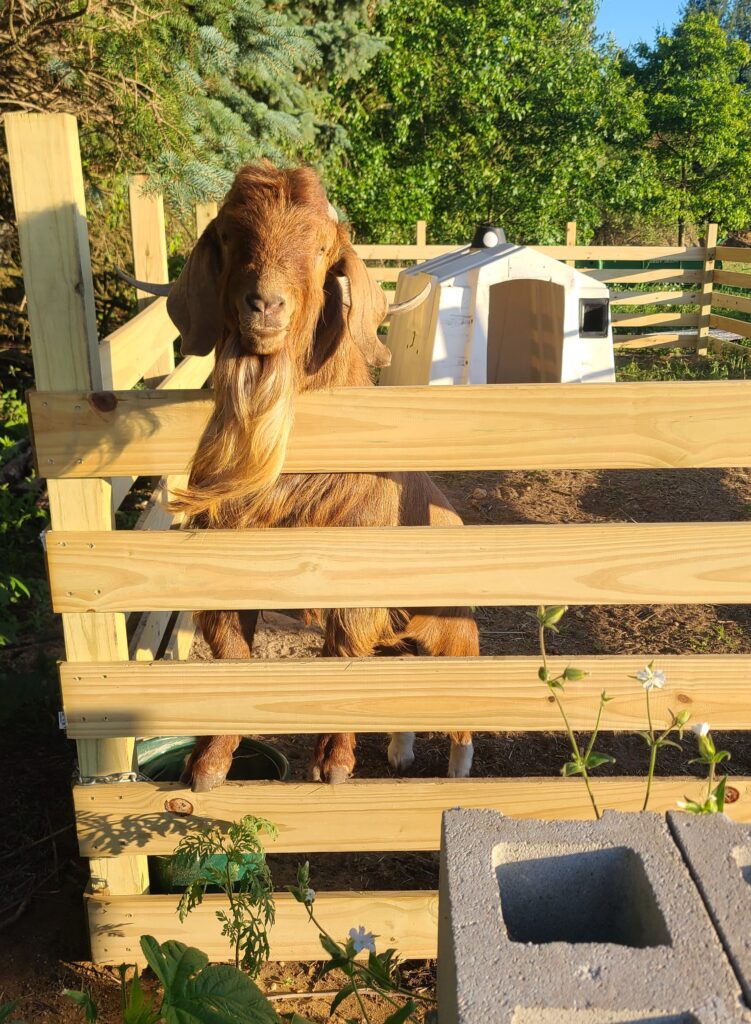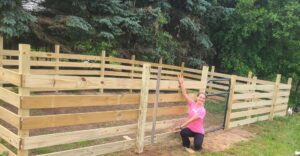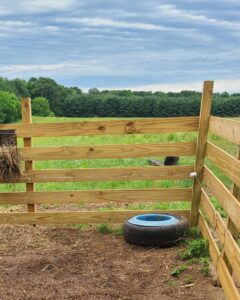Goats are notorious for being escape artists, but keeping a buck in during breeding season can be nearly impossible. Here are some ideas for making a fortress for your male goat that he will be comfortable in and that will contain him, no matter the temptation. A full materials list and instructions for building an esthetic and functional enclosure with wooden fence and hot wire are provided.

This post contains affiliate links. As an Amazon Associate, I earn from qualifying purchases.
A strong, determined, nearly 300-pound horned animal with raging hormones can be hard to contain. We raise Boer and Nubian goats and know from experience the challenges of keeping the boys in when there is a doe in heat in the vicinity.
Over the years, we have had to deal with broken and scaled cattle panels and breeding attempts through fences. This year, we decided to stop messing around and instead invest in a better, more permanent solution to secure our herd sires.
We designed a pen that not only looks nice, but serves its purpose of keeping the bucks where they need to be. The enclosure consists of treated lumber fencing with a single electric wire and a metal gate.
Here is how we made it:
Materials Needed for Making a Buck-Proof Pen
The pen that we made is 16 feet wide by 32 feet long (512 square feet). The general recommendation for space per standard size (non-dwarf) goat is 200 square feet, so this pen can comfortably house two full-sized animals.
- Mason line
- Tape measure
- Spray paint
- Tamping bar
- 16 fence posts (4 in. x 4 in. x 8 ft. AC2 pressure treated lumber)
- 30 boards (1 in. x 6 in. x 16 ft. AC2 pressure treated lumber)
- 2 50-pound bags of ready-to-use concrete mix
- Auger or post hole digger
- Level
- Shovel
- 1 box of 2-inch deck screws
- Power drill
- 4 ft. x 4 ft. metal gate with hardware
- 100 feet of electric fence wire
- 7 ceramic lag screw fencing insulators
- 1 in-line ratchet style electric fence tensioner
- Fencing pliers and crimping sleeves

Directions for Making a Buck-Proof Pen
- Using a mason line and tape measure, determine the desired perimeter for your buck pen.
- Mark the location for the fence posts and gate with spray paint.
We spaced our fence posts 8 feet apart and used a PTO-driven auger to save on digging time. If you don’t have one, you can use post hole diggers or a shovel. We buried our fence posts about 4 feet deep.
When back-filling the holes, remember to tamp the dirt down well and use a level to make sure your fence posts are nice and straight.
When placing the posts on either side of the gate, pour a bag of ready-to-use concrete into the hole then add about a gallon of water to it and mix with a shovel before back-filling with dirt. This will provide strength and stability to the gate, the only part of the enclosure that will not have electric wire to keep the buck off of it.
- Now you are ready to put up some fence boards. We decided to leave 4 inches of space between each board to allow our buck to see other goats and so we could get the hose in or dump out his feed pan without having to get into the pen.
We used a power drill and 2-inch deck screws to secure the treated boards to the fence posts. Pre-drilling pilot holes in the boards is recommended to help prevent splitting and create a smooth finish.
A trick for maintaining even spacing between the boards without measuring each time is to cut scrap wood to 4 inches as a template. To use it, first level and attach the lowest board, then set your templates on top of it, add the next board right on top of the templates, secure with screws, remove the templates, and continue the process. Our fence is 5 boards high and 4 feet tall.
- Once the concrete has set for at least 4 hours, you can mount the gate to the fence posts using the hardware that comes with it.
- We used ceramic lag screw insulators on each side of the gate, the corner posts, and half way down the long side without the gate to suspend the electric wire. We used fencing pliers to cut the wire and an in-line ratchet style tensioner to make it taut.
We opted for just a single electric wire inside our pen, at right around 2 feet high. This prevents the bucks from climbing up on (or over) the fence as well as attempting to go under. It works for us, but if your bucks are more mischievous you can always add an additional wire, or two.
Shelter in the Buck Pen
Your buck needs a place to get out of the sun, wind, or rain. We use plastic calf hutches as shelters for our bucks. They are portable, durable, and easy to clean.
Other options for buck housing are shelters made of wood or metal. In cold weather, make sure your herd sires have clean, dry bedding inside.
Feed and Water in the Buck Pen

Our bucks get free-choice hay in a feeder that we screwed to a fence post. There are lots of options of hay feeders to buy. If you can weld and want to make your own, you can find our post with directions for making a hay feeder from a hog panel here!
For grain, we use a 16-quart tire feeder. It makes good use of an old tire and is virtually indestructible if your bucks like to break things.
For water, we use a flat-backed 20-quart bucket secured to a fence post with a chain. It is easy to dump and refill, but helps deter the animals from tipping it over.
Other Additions to the Buck Pen
Your bucks would love a scratching post and something to climb on in their enclosure. These are not a necessity, but do enrich a buck’s experience and can help him beat boredom.
Good luck keeping your big guy in until breeding season comes around and thanks for reading!

Mother, farmer, author, and teacher by trade… She loves tending to things and watching them grow!

